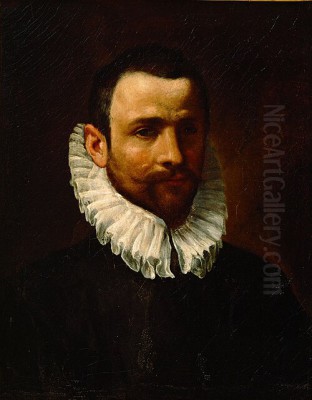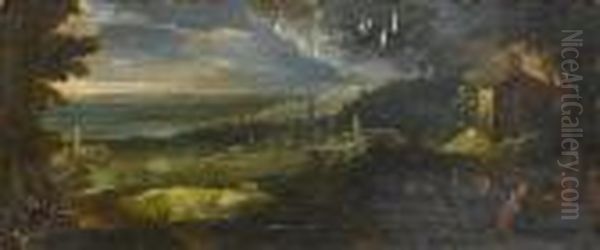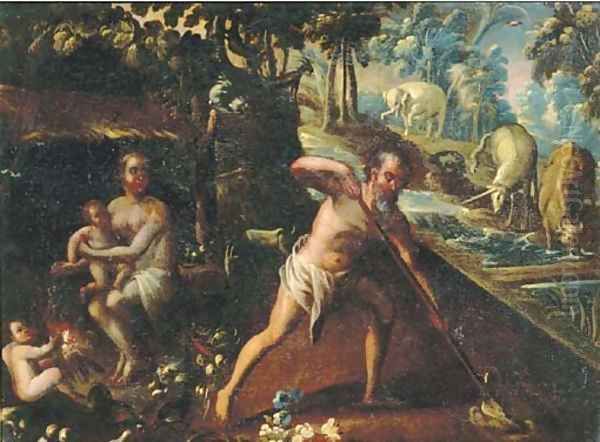
Lodewijk Toeput, known in Italy by the evocative name Pozzoserrato, stands as a fascinating figure bridging the artistic traditions of Northern Europe and Renaissance Italy. A Flemish painter who found fame and fortune far from his homeland, Toeput carved a unique niche for himself, primarily in the Veneto region, becoming celebrated for his imaginative landscapes, vibrant depictions of aristocratic life, and skillful integration of diverse artistic influences. His career exemplifies the rich cross-cultural exchange that characterized European art in the late 16th century.
Origins and Early Training
Born around 1550, Lodewijk Toeput's precise birthplace within Flanders remains uncertain, with both Mechelen and the bustling art center of Antwerp suggested as possibilities. What is clearer is his early artistic education. Historical sources, notably the writings of Karel van Mander, indicate that Toeput was a pupil of Maerten de Vos in Antwerp. De Vos himself was a significant figure, known for his history paintings and portraits, and importantly, he had spent time in Italy, absorbing the lessons of the Italian Renaissance, particularly in Venice where he may have worked in Tintoretto's studio.
This connection likely provided Toeput with an early exposure to Italianate forms and compositions, potentially fueling his desire to travel south. Antwerp, during Toeput's formative years, was a major hub for art production and trade, fostering a dynamic environment where artists were aware of developments across Europe. Training under a master like De Vos would have equipped Toeput with a solid foundation in Flemish techniques, characterized by detailed observation and a refined finish.
The Journey South: Embracing Italy
Like many Northern artists of his generation, Toeput felt the pull of Italy, the heartland of the Renaissance. He embarked on his journey southward probably around the mid-1570s, a period when travel to Italy was almost a requisite step for ambitious Northern European painters seeking to complete their education and broaden their artistic horizons. His travels likely took him through several key Italian artistic centers.

Evidence suggests periods spent in Venice, Florence, and possibly Rome. Venice, in particular, seems to have made a profound impact. The city's unique atmosphere, its lagoon setting, and the dazzling works of its leading masters left an indelible mark on Toeput's developing style. He absorbed the lessons of the great Venetian colorists and masters of light and composition.
Venetian Influences and Connections
During his time in Venice, Toeput encountered the towering figures of the Venetian school. The dramatic intensity and bold brushwork of Jacopo Tintoretto, the opulent colour and grand decorative schemes of Paolo Veronese, and the profound influence of Titian (Tiziano Vecellio) on landscape and colour were all part of the rich artistic tapestry he experienced. While direct apprenticeship is difficult to confirm, some early accounts even speculatively place him within the workshop environment associated with Giorgione, though this remains unproven and likely refers more to an affinity with Giorgione's pastoral and atmospheric style.
He also connected with fellow Netherlandish artists working in Venice. He is known to have associated with Lambert Sustris, another Fleming who had successfully integrated into the Venetian scene, and Paolo Fiammingo (Pauwels Franck), a landscape specialist whose delicate style was sometimes compared to Toeput's own. These interactions fostered a community of expatriate artists who exchanged ideas and techniques, blending their Northern heritage with Italian innovations.
Pozzoserrato of Treviso
While Venice provided crucial inspiration, it was in the nearby mainland city of Treviso that Lodewijk Toeput truly established himself and spent the majority of his productive career. It was here that he became widely known by his Italianized name, Pozzoserrato, which translates roughly to "closed well," though the exact origin or meaning behind this moniker is unclear. He settled in Treviso probably by the early 1580s and remained there until his death.
In Treviso, Pozzoserrato gained considerable renown. He received commissions for altarpieces, frescoes, and easel paintings, becoming a leading artistic figure in the city. His workshop likely employed assistants and pupils, contributing to the dissemination of his style in the region. His success demonstrates how a foreign artist could not only adapt but thrive within the competitive Italian art world.
Artistic Style: A Synthesis of North and South

Pozzoserrato's art is defined by its skillful synthesis of his Flemish roots and his acquired Italian sensibilities. He retained the Northern European love for detail, meticulous rendering of textures, and a keen observation of nature, particularly evident in his landscapes. However, he combined this with the Venetian emphasis on colour (colore), atmospheric effects, and a more fluid, painterly approach than typically found in purely Flemish works of the time.
His style is often described as part of an "international manner," reflecting the cosmopolitan artistic currents of the late 16th century. He moved beyond purely topographical depictions towards more imaginative and idealized views, creating a unique blend that appealed to the sophisticated tastes of his patrons in the Veneto.
Mastery of Landscape
Landscape painting was arguably Pozzoserrato's greatest strength and the genre for which he is most celebrated today. He excelled in various types of landscape. He produced topographical views, contributing, for instance, to the ambitious project of Georg Braun and Frans Hogenberg's Civitates Orbis Terrarum, a collection of city views from across the globe, likely collaborating with the Flemish engraver Joris Hoefnagel on some of these depictions.
However, his most distinctive contributions are his paesaggi fantastici – fantasy landscapes. These works often feature dramatic, imaginary mountain ranges, winding rivers, picturesque ruins, and lush vegetation. While grounded in observation, these landscapes transcend reality, creating poetic and often idyllic settings for mythological or biblical narratives, or simply existing as evocative scenes in their own right. His approach often involved elevated viewpoints, providing panoramic vistas, a technique common among Flemish landscape pioneers like Joachim Patinir and later refined by artists like Pieter Bruegel the Elder.
Depicting Life and Narrative
Beyond pure landscape, Pozzoserrato adeptly integrated figures and narrative elements into his compositions. He painted numerous religious subjects. A notable example is the altarpiece depicting St. Michael Vanquishing the Devil for the church of San Lorenzo in Treviso. Preparatory drawings, such as a sketch showing the Martyrdom of St. John, suggest his careful working process for such commissions. Another recurring religious theme was St. Jerome Penitent in the wilderness, a subject that allowed for the combination of a solitary figure with a wild, expressive landscape.
He also captured the leisurely pursuits of the Venetian and Trevisan aristocracy. Paintings like Feast in the Open Air depict elegant figures enjoying picnics, concerts, and garden parties set within beautifully rendered landscapes, often featuring Palladian-style villas and meticulously designed gardens. These works provide valuable visual documents of elite life in the Veneto during the late Renaissance, showcasing fashion, social customs, and the appreciation for cultivated nature.
The Four Seasons
A particular interest for Pozzoserrato, shared with many Netherlandish artists, was the theme of the seasons. He created cycles depicting the characteristic landscapes and human activities associated with spring, summer, autumn, and winter. One such complete cycle is known to survive in a private collection in Venice. These works often drew inspiration from earlier print series, such as woodcuts by the Monogrammist A.P. dating from 1536.
His seasonal depictions allowed him to explore the changing effects of light and atmosphere throughout the year, further demonstrating his sensitivity to the natural world. This theme connected him to a long tradition in Northern European art, famously exemplified by Pieter Bruegel the Elder's iconic seasonal paintings.
Drawing and Technique
Pozzoserrato was also a proficient draftsman. Surviving drawings, such as his Landscape with Architectural Study, reveal a fluid and confident hand. These sketches often served as preparatory studies for paintings but also stand as artworks in their own right, showcasing his interest in capturing architectural details and experimenting with compositional ideas. His drawings often employ pen and ink with wash, creating rich tonal variations.
In his paintings, he typically worked in oil, often on canvas but sometimes on panel. His technique is characterized by a relatively delicate touch and careful layering of glazes to achieve luminous colour and subtle atmospheric perspective – the way distant objects appear hazier and bluer. He sometimes employed techniques of perspective and foreshortening in slightly exaggerated ways, particularly in the rendering of foliage or figures, contributing to the slightly unreal, fantastical quality of some of his landscapes.
Key Works Revisited
Several works stand out as representative of Pozzoserrato's oeuvre. The St. Michael Vanquishing the Devil altarpiece in Treviso showcases his ability to handle large-scale religious commissions within an Italian context. The various depictions of St. Jerome Penitent highlight his skill in merging figure painting with evocative, wild landscapes.
His Feast in the Open Air paintings encapsulate his elegant depictions of aristocratic leisure and his mastery of integrating figures seamlessly into garden settings. The Cycle of the Seasons demonstrates his engagement with traditional Northern themes and his ability to adapt them with Venetian flair. His numerous landscape drawings reveal his working methods and his innate talent for capturing the essence of place, whether real or imagined. The painting known as The Liar, mentioned in some sources, likely represents his engagement with genre scenes, depicting everyday life or allegorical figures, though its specific subject requires further clarification.
Collaborations, Workshop, and Attribution Challenges
Like many successful artists of his time, Pozzoserrato likely maintained an active workshop in Treviso. This leads to complexities in attribution, as distinguishing the master's hand from that of his assistants or followers can be challenging. His relationship with the slightly younger Flemish landscape painter Joos de Momper is particularly intriguing and debated. Some scholars suggest De Momper may have spent time in Pozzoserrato's workshop during his own Italian sojourn.
This connection fuels controversies surrounding certain works. For example, a painting depicting a Carnival scene, once attributed to Pozzoserrato, has been reconsidered by some scholars as potentially being by De Momper. Similarly, debates exist regarding the aforementioned Cycle of the Seasons, with suggestions that the compositions might rely on sketches provided by De Momper, which Pozzoserrato then executed or elaborated upon. These attribution issues highlight the collaborative nature of art production and the stylistic dialogues occurring between artists, especially those sharing a common background in a foreign land. His documented collaboration with Joris Hoefnagel on views for Braun and Hogenberg's atlas further underscores his engagement with printmaking and collaborative projects.
Later Life, Death, and Legacy
Lodewijk Toeput, or Pozzoserrato, remained active in Treviso until the end of his life. Based on the most reliable documentary evidence, he died in Treviso sometime between 1603 and 1605. (An alternative, less substantiated account suggesting a much later birth and death date seems inconsistent with his known period of activity and connections).
His legacy lies primarily in his contribution to landscape painting. He was a key figure among the Netherlandish artists who traveled to Italy and played a crucial role in developing landscape as an independent genre. His unique fusion of Northern detail and observation with Venetian colour and atmosphere created a highly influential style, particularly within the Veneto. He demonstrated how landscape could be imbued with poetic feeling and imaginative power.
His work anticipates later developments in idealized and romantic landscape painting. He influenced local Trevisan artists and contributed to the ongoing dialogue between Northern and Southern European art traditions. While perhaps not as universally famous today as some of his Italian contemporaries like Tintoretto or Veronese, or Northern landscape pioneers like Bruegel, Pozzoserrato remains a significant artist whose work offers a captivating glimpse into the rich artistic exchanges of the late Renaissance.
Works in Collections
Today, works by Lodewijk Toeput (Pozzoserrato) can be found in various public and private collections across Europe and North America. Significant holdings are, naturally, in Italy, particularly in Treviso itself and in Venetian collections. Museums housing his paintings or drawings include:
The University of Michigan Museum of Art, Ann Arbor (USA)
The Rijksmuseum, Amsterdam (Netherlands)
The Albertina, Vienna (Austria)
The Nationalmuseum, Stockholm (Sweden)
The Kupferstichkabinett (Department of Prints and Drawings) in Basel (Switzerland)
The Kunstmuseum Luzern (Switzerland)
Museum Arnhem (Netherlands)
His works also occasionally appear at auction, indicating continued interest from collectors. The dispersal of his art across these institutions allows audiences worldwide to appreciate the skill and imagination of this Flemish master who made Italy his home. His paintings and drawings continue to charm viewers with their blend of meticulous detail, atmospheric beauty, and imaginative vision.